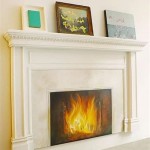DIY Fireplace Blower Grate Heat Exchanger
A fireplace blower grate heat exchanger is a device that uses the heat from a fireplace to warm the surrounding air. This can be a cost-effective way to heat your home, especially if you have a wood-burning fireplace. The blower grate is installed in the fireplace opening, and it uses a fan to circulate hot air from the fire box to the surrounding room. By adding a heat exchanger to your fireplace, you can further increase the efficiency of your fireplace by transferring more heat from the fire to the air in your home.
There are several benefits to using a DIY fireplace blower grate heat exchanger. They can help to reduce your heating bills significantly. They can also help to improve the air quality in your home by circulating fresh air heated by the fireplace. Finally, they are relatively easy to install and maintain, making them a cost-effective choice for homeowners.
How a Fireplace Blower Grate Heat Exchanger Works
The DIY fireplace blower grate heat exchanger usually consists of a metal grate with a fan attached. The grate sits in the fireplace opening, and the fan pushes hot air from the fire box through the grate and into the room. The heat exchanger itself is usually made of metal, and it is designed to absorb heat from the fire and transfer it to the air. The hot air is then circulated throughout the room by the fan.
The heat exchanger works on the principle of convection. Convection is the transfer of heat through the movement of fluids, such as air. In this case, the hot air from the fire rises and is drawn through the heat exchanger by the fan. The heat exchanger absorbs the heat from the air and transfers it to the surrounding air, which is then circulated throughout the room. The result is a warmer room with a more efficient use of the heat from the fire.
Building a DIY Fireplace Blower Grate Heat Exchanger
While there are many pre-made fireplace blower grate heat exchangers available on the market, it is also possible to build your own with a few simple materials. You will need:
- A metal grate, large enough to fit in your fireplace opening.
- A fan, with a diameter that is slightly smaller than the grate.
- Metal sheet, for creating a heat exchanger.
- Screws or bolts.
- Power drill.
- Safety gear including gloves and eye protection.
Once you have gathered the necessary materials, you can begin building the heat exchanger. First, you will need to cut the metal sheet into the desired shape and size. You can either have a professional cut it for you or cut it yourself, but it is important to use safety gear when handling metal sheet. After shaping the metal sheet, you can attach it to the metal grate using screws or bolts. Make sure the heat exchanger is securely attached to the grate so that it won't fall off when the fan is running.
Next, you will need to attach the fan to the grate. You can do this by drilling holes in the grate and attaching the fan to the grate using screws or bolts. The fan should be securely attached so that it does not fall off when the fan is running.
Installing and Using Your DIY Fireplace Blower Grate Heat Exchanger
Once you have built the heat exchanger, you can install it in your fireplace. Place the grate in the fireplace opening and make sure it is level. Plug the fan into an outlet and turn it on. The fan will then begin to circulate hot air from the fire box throughout the room.
To ensure the safe and efficient use of your DIY fireplace blower grate heat exchanger, you should always follow the manufacturer's instructions. You should also keep the following safety tips in mind:
- Never leave the fireplace unattended while it is burning.
- Keep the fan away from flammable materials.
- Do not use the fan if the fireplace is damaged or malfunctioning.
- Keep the fan clean and free of debris.
By following these tips, you can help to ensure the safety and efficiency of your DIY fireplace blower grate heat exchanger.

This Is A Great Small Area Heater For Smaller Fireplace Rated At Over 28 000 Btu Of Heat It Delivers Mor Blower Gas

Grate Heater Wikipedia

Tiny Stainless Grate Fanless Hastyheat

Medium Double Row Tube Fireplace Grate Heater With Dual Blowers Hastyheat

Fire Place Heat Exchanger Fireplace Blower

Cozy Grate Fireplace Heater Woodland Direct

S Fireplace Heat Wood Stove Grate

Grate Heater With Masonry Fireplace Doors Customized

More Heat From The Fireplace I Really Like This Idea Grate Wood Burning Stove

20gr 14 24td Fireplace Grate Heat Exchanger Hasty Hastyheat
Related Posts








